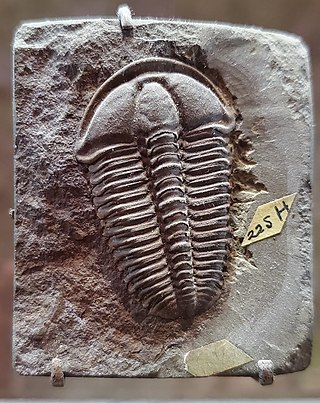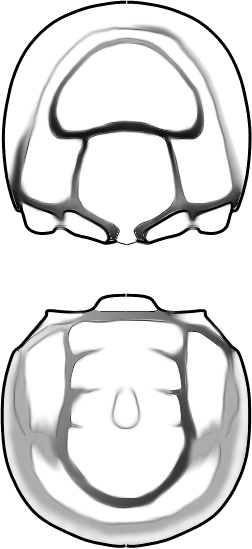
Lichida is an order of typically spiny trilobite that lived from the Furongian to the Devonian period. These trilobites usually have 8–13 thoracic segments. Their exoskeletons often have a grainy texture or have wart or spine-like tubercles. Some species are extraordinarily spiny, having spiny thoracic segments that are as long or longer than the entire body, from cephalon (head) to pygidium (tail). The sections of the pygidia are leaf-like in shape and also typically end in spines.

Phacops is a genus of trilobites in the order Phacopida, family Phacopidae, that lived in Europe, northwestern Africa, North and South America and China from the Late Ordovician until the very end of the Devonian, with a broader time range described from the Late Ordovician. It was a rounded animal, with a globose head and large eyes, and probably fed on detritus. Phacops is often found rolled up ("volvation"), a biological defense mechanism that is widespread among smaller trilobites but further perfected in this genus.

Chotecops is a genus of trilobites from the order Phacopida, suborder Phacopina, family Phacopidae. It was initially erected as a subgenus of Phacops but some later authors thought it distinctive enough to raise its status. Species assigned to this genus occur between the Emsian and the Famennian. Chotecops is the most abundant trilobite in the Hunsrück Slate and due to the excellent preservation, often soft tissue such as antennae and legs have been preserved as a thin sheet of pyrite.

Agraulos is a genus of Solenopleuridae trilobites that lived during the Middle Cambrian in North America and Europe, particularly the Czech Republic. The genus was named by Hawle & Corda in 1847.
Acadagnostus is a genus of trilobite from the Middle Cambrian, with 7 species currently recognized. The type species A. acadicus has the widest distribution known from any peronopsid and has been found in North America, Greenland, England, Western Europe, Eastern Europe, Central Asia, the Altai Mountains, the Siberian shield, China, and Australia.
Atractopyge is a genus of trilobites that lived in what would be Asia and Europe from the middle Ordovician to the early Devonian from 472 to 412.3 mya, existing for approximately 59.7 million years.
Boeckops is a genus of trilobites in the order Phacopida, which existed in what is now the Czech Republic. It was described by Chlupac in 1972, and the type species is Boeckops boecki, which was originally described as Phacops boecki by Hawle and Corda in 1847. Boeckops is also been discriped from the lower Devonian of Morocco and Algeria. The Genus Boeckops is interpreted as intermediate from between the traditional genus concept of Phacops and Reedops. The Genus Boeckops is regarded as problematic or difficult by McKellar et Chatterton 2009.
Struszia is a genus of fossil trilobites from the Silurian period, erected in 1993 and named after paleontologist Desmond L. Strusz.

Aulacopleura is a genus of proetid trilobite that lived from the Middle Ordovician to the Middle Devonian. Some authors may classify this group as subgenus Otarion (Aulacopleura). The cephalon is semicircular or semielliptical, with border and preglabellar field. The glabella is short, with or without defined eye ridges connecting it with eyes of variable size. Spines at the rear outer corners of the cephalon are present, typically reaching back to the 2nd to 4th thorax segment. The 'palate' is not connected to the dorsal shield of the cephalon. The cephalon is pitted, or has small tubercles. The thorax has up to 22 segments. The pleural ends are usually rounded. The pygidium is small (micropygous), with an even margin. A. koninckii had a modern type of compound eye.
Phalacroma is a genus of trilobite in the order Agnostida, which existed in what is now the Czech Republic. It was described by Hawle and Corda in 1867, and the type species is Phalacroma bibullatus, which was originally described as a species of Battus by Barrande in 1846.

Conocoryphe is a genus of primarily eyeless trilobites belonging to the family Conocoryphidae. They lived during the Middle Cambrian period, about 505 million years ago. These arthropods lived on the sea bottom (epifaunal) and lived off dead particulate organic matter.

Lejopyge laevigata is a species of agnostid trilobite belonging to the genus Lejopyge. It existed during the Guzhangian to the Paibian Age of the Cambrian. It has a cosmopolitan distribution and is an important index fossil in biostratigraphy.

The Condylopygidae are a family of small trilobites that lived during the Middle Cambrian, and found in Canada, the Czech Republic, Germany, France, Spain, England, Wales, Sweden, and the Russian Federation (Siberia). They uniquely differ from all other Agnostina in having the frontal glabellar lobe wider than the rear lobe. The Condylopygidae are the only family assigned to the superfamily Condylopygoidea.

Pleuroctenium is an agnostid trilobite belonging to the family Condylopygidae Raymond (1913). The genus occurs in Middle Cambrian (Drumian) strata of Canada, the Czech Republic, England and Wales, France, and Sweden.
Diplorrhina Hawle and Corda (1847) is a genus of trilobite belonging to Order Agnostida. It lived during the early Middle Cambrian in what are now the Czech Republic and the North Siberian plateau. as in members of the family Peronopsidae it lacks a preglabellar furrow. Both cephalon and pygidium lack spines. It is difficult to distinguish Diplorrhina from many other peronopsids.
ConocephalitesBarrande, 1852, is a disused name for a genus of trilobite, of which the species have now been reassigned to other genera. The name was introduced as a replacement for ConocephalusZenker, 1833, which was unavailable since Thunberg used it in 1815 for a genus of conehead bushcricket. Barrande however was unaware that Conocoryphe had already been proposed by Hawle and Corda in 1847.
ArionellusBarrande, 1850, is a disused name for a genus of trilobite. The name Arionellus was a replacement for ArionidesBarrande, 1847, itself a replacement for ArionBarrande, 1846, which was preoccupied because Férussac had already used it in 1819 for a genus of slugs.

Styginidae is a family of trilobite in the order Corynexochida. Fossils of the various genera are found in marine strata throughout the world, aged from Ordovician up until the family's extinction during the Silurian.

The Paradoxidoidea Hawle & Corda 1847, are a superfamily of trilobites, a group of extinct marine arthropods. They occurred during the late Lower Cambrian (Toyonian) and disappeared at the end of the Middle Cambrian.
Tropidocoryphidae is an extinct family of trilobites in the order Proetida.












